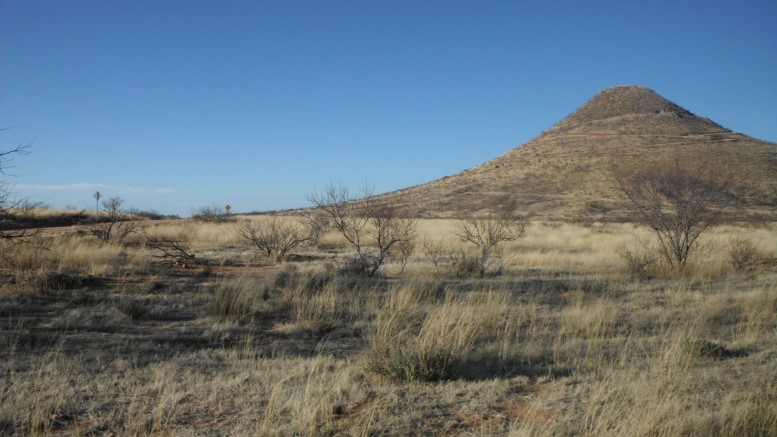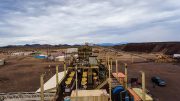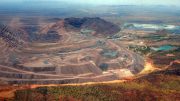GMV Minerals (TSXV: GMV; US-OTC: GMVMF) has released results of an updated preliminary economic assessment for its wholly owned Mexican Hat gold project in southeastern Arizona, 116 km from Tucson.
The PEA outlined an open-pit heap-leach mine with a mine life of 10 years, producing a total of 525,000 oz. gold at average all-in sustaining costs (AISCs) of US$1,136 per ounce.
Initial capex was pegged at US$67.85 million, and the payback period is expected to take under three years. The early-stage study estimated an after-tax net present value of US$100 million, at a 5% discount rate, with an after-tax internal rate of return of 29.3%, at a base case gold price of US$1,600 per ounce.
The PEA was based on an inferred resource estimate of 36.73 million tonnes grading 0.58 gram gold per tonne for 688,000 contained oz. gold.
“The updated study not only increased the mine life and greatly reduced initial capex but also led to a significantly improved strip ratio from 2.8 to 1.87,” Ian Klassen, the company’s CEO, said in an interview. “The PEA results are not bad for a junior that has spent only $5 million on this asset. We’ve been able to demonstrate that we’ve spent our shareholder’s money wisely and will continue to do so.”
Klassen and his team believe significant expansion potential exists along strike and down dip on the principal controlling structure outside of the resource area, and plan to conduct an infill drill program next year and release an updated resource estimate, as well as do metallurgical testwork in an effort to optimize and improve heap leach gold recoveries.
A trade-off study will follow to determine whether GMV should mine the project on its own or use contract miners. Other work programs planned include geotechnical drilling and analysis to optimize the pit slope design, continued baseline water sampling, and updating hydrological, cultural, and environmental studies for permitting purposes.
Mexican Hat is located close to several mines, including Mako Mining’s (TSXV: MKO; US-OTC: MAKOF) Commonwealth gold and silver mine, 10 km to the south, and Excelsior Mining’s (TSX: MIN; US-OTC; EXMGF) Gunnison copper mine, 30 km to the northwest.
The property lies within the southeastern portion of the Basin and Range Province, which encompasses much of Nevada, southeast California, southern Arizona, and parts of New Mexico.
Klassen noted that the project has gone through sporadic ownership over the years. Placer Dome Inc. conducted the bulk of exploration activities between 1989 and 1990, including 137 reverse circulation drill holes and 17 diamond core drill holes totalling 18,939 metres.
“The project was discovered in the 1980s by a local prospector called Manuel Hernandez, who sadly passed away last year,” Klassen said. “We’d known about the property for some time and around 2014 Auracal Resources, the operator of the property, defaulted on their lease agreement with the Hernandez family.”
In 2014, GMV acquired a 100% interest in the property and in the fall of that year, conducted a five-week mapping and sampling program to confirm and expand upon work completed by past operators, which included Placer Dome. The program demonstrated economically significant gold values distributed within multiple mineralised zones within an area 640 metres long and 525 metres wide, according to GMV.
After completing its first resource on the project in 2015, the company undertook column leach testing on bulk samples that had been collected from two trenches, and testwork yielded gold recoveries of 96.6% and 91.6%. Two bottle roll tests on each sample returned gold recoveries of 95% and 77.1%.
“The metallurgical work confirmed earlier testing by Placer Dome and supported our view that the project had the potential for a low-cost, open-pit heap leach operation,” David Webb, a consultant geologist to GMV and acting project manager, said in the interview.
In 2016, a geochemical study of 663 soil samples identified a new target, Hernandez Hill, about 500 metres northeast of the existing resource.
“The discovery was very surprising, and the combination of a strong pathfinder geochemical signature, including gold, suggested an epithermal system that may contain economic concentrations of gold and silver,” Klassen said.
The company then released the results from its 2016 winter drill program from the main deposit in March 2017. The 15-hole step-out drill program expanded the known mineralisation to the southeast and northeast. Highlights included drill hole GMV 2016-11, which intersected 33.5 metres grading 0.92 gram gold starting from 15.2 metres downhole, and hole GMV 2016-8, which returned 21.3 metres grading 0.74 gram gold from 152.4 metres. These step-outs expanded the known mineralised zones another 420 metres to the southeast, the company said.
The geophysical surveys traced the mineralisation to a depth of 500 metres and identified new target zones 100 metres south of Hernandez Hill.
By the end of 2017, 23 out of the 28 step-out drill holes encountered gold mineralisation at the main deposit above the previously established 0.2 gram gold cut-off grade that had been used for the resource estimate.
The drilling extended the known surface mineralised area from 15.5 hectares to 34.1 hectares, with the mineralisation remaining open to the north, southeast, and to depth.
The company updated the resource estimate in July 2018 and an 11-hole step-out drill program completed in August 2019 was designed to extend the known mineralisation into areas of the pit model with limited or no historical drilling. Due to the lack of drilling, the company had classified these areas as waste tonnage.

Drill rigs operating during the 2019 drill program at Mexican Hat. Credit: GMV Minerals.
The drilling tested the northern extent of the known mineralisation. Highlights included drill hole MHRC 19-8, which intersected 18 metres grading 1.24 grams gold from 201 metres, and hole MHRC 19-4, which returned 12 metres grading 1.19 grams gold from 207 metres. A third hole, MHRC 19-1, confirmed economically significant mineralisation in a second pit located in the property’s southeast. That hole cut 3 metres of 1.22 grams gold from 76 metres.
The company also launched a soil geochemistry program focusing on Little Hat, about 3.4 km south of the Mexican Hat deposit, where a ground magnetic survey identified a near-surface anomaly, and returned anomalous gold levels in pathfinder elements, including antimony, tellurium, and arsenic. The results demonstrated that the area had a similar geochemical signature to Mexican Hat, according to the company.
Since completing an updated resource estimate in June and its PEA earlier this month, the company is waiting to permit a four-hole drill program to test Little Hat.
“We have been planning to drill test Little Hat for some time now,” Klassen said. “The Little Hat target has all the same markers as its larger cousin a few hundred meters to the north and presents an excellent opportunity to extend the areas of known mineralization.”
The company also plans to conduct two drill programs in 2021. The first is a step-out drill program along strike and down dip on the principal controlling structure outside of the current resource area and is designed to expand the northern and southeastern extensions of the known mineralisation.
The second is a 30-hole infill drill program totalling about 4,000 metres within the two constrained-pits and is slated to begin in mid-2021. The drilling is designed to upgrade the current resource from the inferred to measured and indicated category.
“The conversion from inferred to measured and indicated resources is an art form and very subjective,” Webb said. “Much of this infill drilling is to confirm or reject past Placer Dome drill holes so we can feel comfortable enough call it measured or indicated, while everything else will stay in the inferred category.”
At press time in Toronto, GMV Minerals was trading at 28¢ per share within a 52-week trading range of 7.5¢ and 35¢. The company has 55.7 million common shares outstanding for a $15.6-million market capitalization.






Be the first to comment on "GMV Minerals advances Mexican Hat project in Arizona"